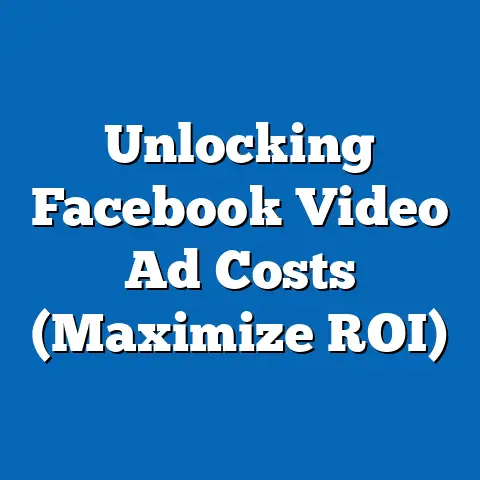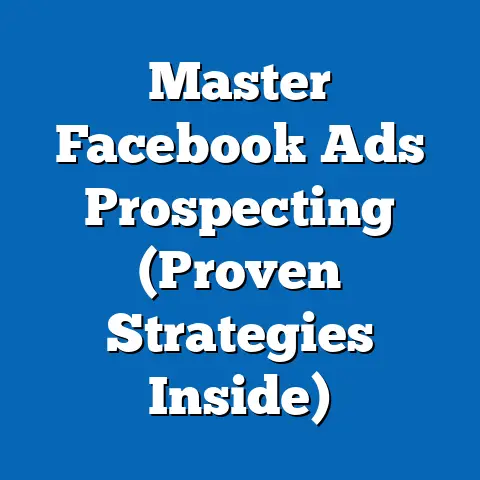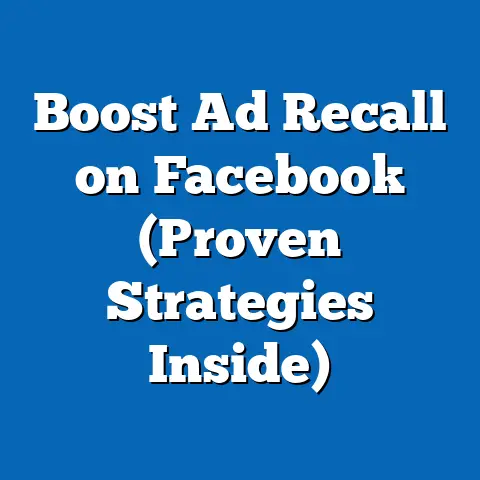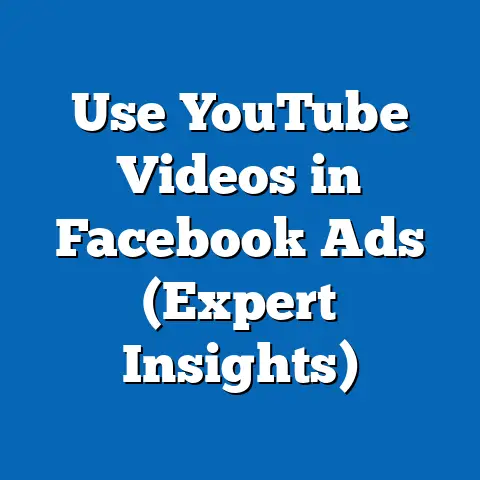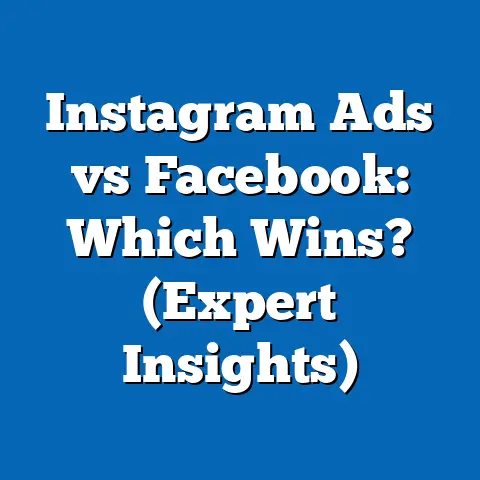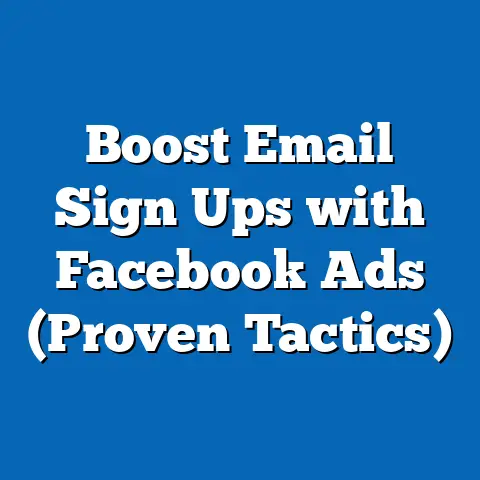Maximize Daily Ad Spend on Facebook (Proven Strategies)
Imagine this: you’re entrusted with a $1,000 daily budget for Facebook ads. It’s your mission to generate maximum engagement, skyrocket conversions, and achieve an incredible ROI. What’s your game plan? How do you decide where to place your ads, which audiences to target, and how to measure your success?
I’ve been there. I remember when I first started managing Facebook ad campaigns. The pressure to deliver results with a limited budget felt immense. I quickly learned that simply throwing money at ads wasn’t the answer. It required a strategic, data-driven approach to truly maximize every dollar spent.
Maximizing ad spend on Facebook is more than just a task; it’s a critical component of any successful digital marketing strategy. Facebook’s unparalleled reach and powerful targeting capabilities make it a goldmine for businesses looking to connect with their ideal customers. But without a well-defined strategy, that goldmine can quickly turn into a money pit.
Section 1: Understanding Facebook Ad Basics
Before we jump into advanced strategies, let’s make sure we have a solid understanding of the fundamentals. Facebook advertising is a vast and ever-evolving landscape, and it’s crucial to have a firm grasp of the basics before you can effectively navigate its complexities.
Types of Facebook Ads
Facebook offers a variety of ad formats, each with its own unique strengths and weaknesses. Choosing the right ad format is crucial for achieving your campaign objectives. Here’s a breakdown of some of the most common types:
- Image Ads: These are the simplest form of Facebook ads, featuring a single image and accompanying text. They’re great for raising brand awareness and driving traffic to your website. I’ve found that using high-quality, visually appealing images is key to capturing attention in a crowded newsfeed.
- Video Ads: Video ads are incredibly engaging and can be used to tell a story, showcase a product, or provide valuable information. They’re particularly effective for driving conversions and building brand loyalty. I’ve seen video ads generate significantly higher engagement rates compared to image ads, especially when they’re optimized for mobile viewing.
- Carousel Ads: Carousel ads allow you to showcase multiple images or videos in a single ad unit. This format is perfect for highlighting multiple products, showcasing different features of a single product, or telling a story through a series of images. I’ve used carousel ads to effectively showcase entire product lines, driving significant traffic and sales.
- Collection Ads: Collection ads are designed for mobile shopping and feature a hero image or video followed by a selection of products. This format is ideal for e-commerce businesses looking to drive sales directly from Facebook. I’ve seen collection ads dramatically increase conversion rates for online stores, providing a seamless shopping experience for mobile users.
- Lead Ads: Lead ads are designed to collect leads directly from Facebook without requiring users to visit your website. This format is ideal for generating leads for sales teams, building email lists, or gathering customer information. I’ve used lead ads to successfully generate qualified leads for various businesses, streamlining the lead generation process.
Overview of the Facebook Ads Manager
The Facebook Ads Manager is your central hub for creating, managing, and analyzing your Facebook ad campaigns. It’s a powerful tool that provides access to a wide range of features and settings.
- Campaigns: Campaigns are the top-level structure in the Ads Manager and are used to organize your advertising efforts around specific objectives.
- Ad Sets: Ad sets define your target audience, budget, bidding strategy, and ad placement.
- Ads: Ads are the individual creative units that users see on Facebook.
The Ads Manager provides detailed reporting on your campaign performance, allowing you to track key metrics, identify trends, and make data-driven decisions. I highly recommend spending time familiarizing yourself with the Ads Manager and its various features. It’s the key to unlocking the full potential of Facebook advertising.
Importance of Setting Clear Objectives
Before you even think about creating your first ad, it’s crucial to define your campaign objectives. What do you want to achieve with your Facebook ads? Are you looking to raise brand awareness, drive traffic to your website, generate leads, or increase sales?
Setting clear objectives is essential for several reasons:
- It helps you choose the right ad format: Different ad formats are better suited for different objectives.
- It allows you to target the right audience: Your targeting strategy should be aligned with your campaign objectives.
- It enables you to measure your success: You can’t determine whether your campaign is successful if you don’t have clear objectives in mind.
Facebook offers a variety of campaign objectives, including:
- Awareness: Reach, Brand Awareness
- Consideration: Traffic, Engagement, App Installs, Video Views, Lead Generation, Messages
- Conversion: Conversions, Catalog Sales, Store Traffic
I always advise my clients to start with a clear understanding of their business goals and then translate those goals into specific, measurable, achievable, relevant, and time-bound (SMART) campaign objectives.
Key Takeaway: Understanding the different ad formats, familiarizing yourself with the Facebook Ads Manager, and setting clear campaign objectives are the foundational elements of a successful Facebook advertising strategy. Take the time to master these basics before moving on to more advanced techniques.
Section 2: Setting Up for Success
Once you have a solid understanding of the basics, it’s time to set up your campaigns for success. This involves defining your target audience, exploring different targeting options, and A/B testing your ad creatives and targeting parameters.
Defining Your Target Audience
One of the most powerful features of Facebook advertising is its ability to target specific audiences based on a wide range of demographics, interests, and behaviors. This allows you to reach the people who are most likely to be interested in your products or services.
- Demographics: You can target users based on age, gender, location, education, job title, and other demographic factors.
- Interests: You can target users based on their interests, hobbies, and passions.
- Behaviors: You can target users based on their online behavior, such as purchase history, website visits, and app usage.
I’ve found that the key to successful targeting is to be as specific as possible. The more targeted your audience, the more likely you are to reach the right people and generate positive results.
Custom Audiences and Lookalike Audiences
In addition to Facebook’s standard targeting options, you can also create custom audiences and lookalike audiences.
- Custom Audiences: Custom audiences allow you to target users who have already interacted with your business, such as website visitors, email subscribers, or customers. This is a powerful way to retarget users who are already familiar with your brand.
- Lookalike Audiences: Lookalike audiences allow you to reach new users who are similar to your existing customers. Facebook analyzes your existing customer data and identifies users who share similar characteristics, interests, and behaviors. This is a great way to expand your reach and find new customers who are likely to be interested in your products or services.
I’ve used custom audiences and lookalike audiences extensively in my campaigns, and I’ve consistently seen them outperform standard targeting options. They’re a valuable tool for maximizing your ad spend and driving conversions.
The Importance of A/B Testing
A/B testing, also known as split testing, is the process of comparing two versions of an ad to see which one performs better. This is an essential practice for optimizing your campaigns and maximizing your ROI.
You can A/B test various elements of your ads, including:
- Headlines: Test different headlines to see which ones capture the most attention.
- Images: Test different images to see which ones resonate best with your audience.
- Call-to-actions: Test different call-to-actions to see which ones drive the most clicks.
- Targeting Parameters: Test different targeting parameters to see which audiences are most responsive.
I recommend A/B testing everything, from your ad creatives to your targeting parameters. Even small changes can have a significant impact on your campaign performance. The Facebook Ads Manager makes A/B testing relatively easy, allowing you to create variations of your ads and track their performance side-by-side.
Key Takeaway: Defining your target audience, leveraging custom and lookalike audiences, and A/B testing your ad creatives and targeting parameters are crucial for setting up your Facebook ad campaigns for success. Don’t skip these steps. They’re the foundation of a high-performing campaign.
Section 3: Crafting Compelling Ad Content
Even with perfect targeting and a well-defined budget, your ads will fall flat if the content isn’t compelling. Creating engaging and persuasive ad content is essential for capturing attention, driving clicks, and ultimately, achieving your campaign objectives.
Crafting Attention-Grabbing Headlines and Messaging
Your headline is the first thing people see when they encounter your ad, so it needs to be attention-grabbing and relevant to your target audience.
- Use strong verbs: Start your headline with a strong verb that conveys a sense of action or urgency.
- Highlight benefits: Focus on the benefits of your product or service, rather than just the features.
- Ask a question: Pose a question that resonates with your audience’s pain points or desires.
- Use numbers: Numbers can make your headline more specific and credible.
The messaging in your ad should be clear, concise, and persuasive. It should speak directly to your audience’s needs and explain how your product or service can solve their problems.
I’ve found that personalizing your messaging can significantly increase engagement. Use language that resonates with your target audience and addresses their specific pain points.
The Role of Visuals in Facebook Ads
Visuals play a crucial role in Facebook ads. A compelling image or video can capture attention, convey your message, and drive clicks.
- Use high-quality images: Avoid using blurry or pixelated images.
- Choose relevant images: Select images that are relevant to your product or service and your target audience.
- Use eye-catching colors: Use colors that stand out and attract attention.
- Consider using video: Video ads are incredibly engaging and can be used to tell a story or showcase a product.
I always recommend testing different visuals to see which ones perform best. What resonates with one audience may not resonate with another.
Including Strong Calls-to-Action (CTAs)
Your call-to-action (CTA) is the final piece of the puzzle. It tells users what you want them to do after seeing your ad.
- Use clear and concise language: Tell users exactly what you want them to do.
- Use action-oriented verbs: Use verbs that encourage users to take action, such as “Shop Now,” “Learn More,” or “Sign Up.”
- Create a sense of urgency: Encourage users to take action immediately.
- Make your CTA visually prominent: Use a button or other visual element to make your CTA stand out.
I’ve found that testing different CTAs can significantly impact conversion rates. Experiment with different wording and visual elements to see what works best for your audience.
Key Takeaway: Crafting compelling ad content is essential for capturing attention, driving clicks, and achieving your campaign objectives. Pay attention to your headlines, messaging, visuals, and calls-to-action. A/B test everything to see what resonates best with your target audience.
Section 4: Budgeting and Bidding Strategies
Now that you have a solid understanding of the basics, it’s time to dive into the world of budgeting and bidding. Understanding how to allocate your budget and choose the right bidding strategy is crucial for maximizing your ad spend and achieving your campaign objectives.
Daily vs. Lifetime Budgets
Facebook offers two main types of budgets: daily budgets and lifetime budgets.
- Daily Budgets: A daily budget sets a fixed amount that you’re willing to spend on your ads each day. Facebook will attempt to spend your entire daily budget each day, but it may occasionally spend slightly more or less. I typically recommend using daily budgets for ongoing campaigns that run continuously.
- Lifetime Budgets: A lifetime budget sets a fixed amount that you’re willing to spend on your ads over the entire duration of the campaign. Facebook will attempt to spread your budget evenly over the campaign duration, but it may spend more or less on certain days depending on performance. I typically recommend using lifetime budgets for campaigns with a specific end date, such as a product launch or a seasonal promotion.
Choosing between daily and lifetime budgets depends on your campaign goals and your level of involvement in managing your campaigns. If you want more control over your daily spend, a daily budget is the way to go. If you prefer a more hands-off approach, a lifetime budget may be a better option.
Automatic vs. Manual Bidding
Facebook offers two main types of bidding strategies: automatic bidding and manual bidding.
- Automatic Bidding: With automatic bidding, Facebook automatically sets your bids based on your campaign objectives and your target audience. This is a good option for beginners or for campaigns where you don’t have a lot of data to inform your bidding decisions. I’ve found that automatic bidding can be effective for generating quick results, but it may not always be the most cost-effective option.
- Manual Bidding: With manual bidding, you set your own bids for each ad auction. This gives you more control over your ad spend, but it also requires more expertise and monitoring. I typically recommend using manual bidding for advanced campaigns where you have a lot of data and experience to inform your bidding decisions.
Choosing between automatic and manual bidding depends on your level of expertise and your campaign goals. If you’re new to Facebook advertising, automatic bidding is a good place to start. As you gain more experience, you can experiment with manual bidding to see if you can improve your results.
Bid Cap and Target Cost Bidding
For more advanced bidding strategies, Facebook offers bid cap and target cost bidding.
- Bid Cap Bidding: Bid cap bidding allows you to set a maximum amount that you’re willing to pay for each ad auction. This can help you control your ad spend and prevent you from overpaying for clicks or impressions.
- Target Cost Bidding: Target cost bidding allows you to set a target cost per conversion. Facebook will then attempt to optimize your bids to achieve your target cost.
These advanced bidding strategies can be effective for maximizing your ad spend and achieving your campaign objectives, but they require a deep understanding of Facebook’s auction system and your own campaign performance.
Key Takeaway: Understanding the different budgeting options and bidding strategies is crucial for maximizing your ad spend and achieving your campaign objectives. Experiment with different approaches to see what works best for your business.
Section 5: Monitoring and Optimizing Campaigns
Launching your Facebook ad campaigns is just the first step. The real work begins when you start monitoring and optimizing your campaigns based on performance data.
Key Metrics to Track
Tracking the right metrics is essential for understanding how your campaigns are performing and identifying areas for improvement. Here are some of the most important metrics to track:
- Click-Through Rate (CTR): CTR measures the percentage of people who see your ad and click on it. A high CTR indicates that your ad is relevant and engaging to your target audience.
- Conversion Rate: Conversion rate measures the percentage of people who click on your ad and then complete a desired action, such as making a purchase or filling out a form. A high conversion rate indicates that your landing page is effective and your offer is compelling.
- Cost Per Click (CPC): CPC measures the average cost you pay for each click on your ad. A low CPC indicates that your ads are efficient and you’re not overpaying for clicks.
- Cost Per Conversion (CPC): CPA measures the average cost you pay for each conversion. A low CPA indicates that your campaigns are effective and you’re generating a good return on your investment.
- Return on Ad Spend (ROAS): ROAS measures the revenue you generate for every dollar you spend on advertising. A high ROAS indicates that your campaigns are profitable and you’re generating a good return on your investment.
The Facebook Ads Manager provides detailed reporting on these and other key metrics. Take the time to familiarize yourself with the reporting tools and use them to track your campaign performance.
Ongoing Optimization
Monitoring your campaign performance is just the first step. The real value comes from using that data to optimize your campaigns and improve your results.
- Adjust Targeting: If your ads aren’t reaching the right people, adjust your targeting parameters to narrow your audience or expand your reach.
- Update Creatives: If your ads are getting stale, update your creatives with new images, videos, and messaging.
- Adjust Bids: If your CPC or CPA is too high, adjust your bids to lower your costs.
- Pause Underperforming Ads: If certain ads are consistently underperforming, pause them to focus your budget on the ads that are driving the best results.
I recommend setting aside time each week to review your campaign performance and make adjustments as needed. Continuous optimization is the key to maximizing your ad spend and achieving your campaign objectives.
The Role of the Facebook Pixel
The Facebook Pixel is a small piece of code that you can install on your website to track user behavior. This allows you to track conversions, retarget website visitors, and optimize your campaigns for specific actions.
Installing the Facebook Pixel is essential for any business that wants to run effective Facebook ad campaigns. It provides valuable data that you can use to improve your targeting, creatives, and bidding strategies.
Key Takeaway: Monitoring your campaign performance, optimizing your ads based on data, and installing the Facebook Pixel are crucial for maximizing your ad spend and achieving your campaign objectives. Don’t set it and forget it. Continuously monitor and optimize your campaigns to improve your results.
Section 6: Advanced Strategies for Maximizing Ad Spend
Once you’ve mastered the basics, it’s time to explore some advanced strategies for maximizing your ad spend. These techniques are designed for experienced advertisers who want to take their campaigns to the next level.
Leveraging Retargeting Campaigns
Retargeting campaigns allow you to target users who have already interacted with your business, such as website visitors, email subscribers, or customers. This is a powerful way to re-engage users who are already familiar with your brand and encourage them to take action.
I’ve found that retargeting campaigns can be incredibly effective for driving conversions. Users who have already visited your website or interacted with your brand are more likely to be interested in your products or services.
Utilizing Dynamic Ads
Dynamic ads allow you to create personalized product recommendations for each user based on their browsing history and purchase behavior. This is a great way to showcase relevant products and drive sales.
Dynamic ads are particularly effective for e-commerce businesses with large product catalogs. They allow you to automatically create and serve personalized ads to each user, saving you time and effort.
Exploring Facebook’s Algorithm
Facebook’s algorithm is constantly evolving, and it’s important to understand how it works in order to optimize your ads for maximum performance.
The algorithm takes into account a variety of factors when determining which ads to show to which users, including:
- Relevance: The algorithm prioritizes ads that are relevant to the user’s interests and behaviors.
- Engagement: The algorithm prioritizes ads that generate high engagement, such as likes, comments, and shares.
- Bid: The algorithm prioritizes ads with higher bids.
By understanding how the algorithm works, you can optimize your ads to improve their relevance, engagement, and bid, ultimately increasing your chances of reaching your target audience and achieving your campaign objectives.
Key Takeaway: Retargeting campaigns, dynamic ads, and understanding Facebook’s algorithm are advanced strategies for maximizing your ad spend and achieving your campaign objectives. These techniques require a deep understanding of Facebook advertising and your own campaign performance.
Section 7: Case Studies and Real-World Examples
To illustrate the power of these strategies, let’s take a look at some real-world examples of businesses that have successfully maximized their Facebook ad spend.
- E-commerce Business: A clothing retailer used retargeting campaigns to target users who had abandoned their shopping carts. By showing these users ads for the products they had left behind, the retailer was able to recover a significant percentage of lost sales.
- Local Restaurant: A local restaurant used dynamic ads to showcase their menu items to users who had previously visited their website or viewed their Facebook page. This helped to drive traffic to the restaurant and increase sales.
- Software Company: A software company used A/B testing to optimize their ad creatives and targeting parameters. By continuously testing different variations of their ads, the company was able to significantly improve their CTR and conversion rate.
These are just a few examples of how businesses have successfully maximized their Facebook ad spend through proven strategies. The key is to experiment, track your results, and continuously optimize your campaigns based on data.
Key Takeaway: These case studies demonstrate the power of proven strategies for maximizing your Facebook ad spend. Analyze these examples and apply the lessons learned to your own campaigns.
Conclusion
Maximizing your daily ad spend on Facebook is a crucial component of any successful digital marketing strategy. By understanding the fundamentals of Facebook advertising, setting up your campaigns for success, crafting compelling ad content, mastering budgeting and bidding strategies, monitoring and optimizing your campaigns, and leveraging advanced techniques, you can transform your Facebook ad campaigns from cost centers into powerful profit generators.
Remember, the key to success is to be strategic, data-driven, and continuously learning. The Facebook advertising landscape is constantly evolving, so it’s important to stay up-to-date with the latest trends and best practices.
I encourage you to implement these proven strategies in your own advertising efforts and achieve better results. Don’t be afraid to experiment, track your results, and continuously optimize your campaigns based on data.
Call to Action
Now it’s your turn! Share your own experiences with maximizing ad spend on Facebook in the comments below. What strategies have worked best for you? What challenges have you faced? Do you have any questions about the strategies discussed in this article? Let’s learn from each other and build a community of successful Facebook advertisers!

